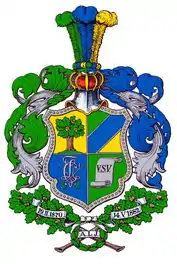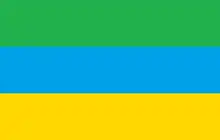| Lettonia | |
|---|---|
 | |
| Founded | 1870, reestblished 1989 Tartu University |
| Type | Literary and fencing |
| Scope | Local |
| Motto | Vitam, salutem, veritatem (Life, prosperity, truth) |
| Symbol | Rapier |
| Chapters | 1 |
| Members | 400 collegiate |
| Headquarters | Rūpniečias iela 4a Riga LV-1010 Latvia |
| Website | lettonia |
Lettonia is a Latvian student fraternity, called a corporation in Latvia. It is the oldest active student fraternity in the country.[1]
History
Students at Tartu University established the fraternity Tērbata Latvian in 1870.[2][3] Its name changed to Fraternitas Lettonica on December 3, 1881.[2] Its current name, Lettonia, was adopted on February 20, 1882, when the government allowed the ethic-Latvian fraternity to incorporate.[2][4] It expanded to the University of Latvia.[5]
In this era, activities included cultural activities, oratory, singing, and festival banquets.[4] Membership was limited to ethnic Latvians; Jews, Russians, and Germans were not allowed to join.[3] A modern historian notes that this was consistent with Latvia at the time—unwelcoming to those who were not of its own.[3]
Members of Lettonia fought for their country during World War I.[2] During the occupation of Latvia, the fraternity ceased its operations.[2] Some members were imprisoned while others managed to emigrate to safety.[2] Before World War II, there were an estimated 500 members still in Latvia.[2] At least seven members were early Nazi collaborators under the leadership of Lettonia member Viktors Arājs.[3][2] Arājs set up Nazi recruitment tables in front of the Lettonia headquarters.[3] The Lettonia presence was common enough amongst the Latvian–German collaborators that the Jews of the Riga ghetto called their guards "Arājsen Burschen" or "Arājs's fraternity brothers".[3] However, more than half of the Lettonia membership had left Latvia by the end of the war.[2]
Reestablishment
In 1989, Latvia was again free and the restored country's statutes were adopted on May 18, 1989.[2] Rector J. Zakis approved the restoration of Lettonia to the country's colleges on July 4, 1989.[2] Lettonia accepted its first class of new members in the fall of 1989.[2] In 2020, it had around 150 (Latvian: pusotrs simts) with about 250 members living outside Latvia.[1]

Symbols
The fraternity's name was selected based on the Latin version of their country's name.[3]
Its motto is "vitam, salutem, veritatem" or "Life, prosperity, truth".[1] The rapier is its symbol, representing masculinity and courage.[1]
Activities
The fraternity holds literary evenings which are designed to expand its members' knowledge of topics such as art, history, literature, and science.[1] and fencing.[1] Fencing is also an important activity, included to help members to overcome fear and develop heroism.[1]
Notable members
- Viktors Arājs – Latvian German collaborator and Nazi SS SD officer[6][7]
References
- 1 2 3 4 5 6 7 "Par Lettoniu – Studentu korporācija "Lettonia"". lettonia.lv (in Latvian). Retrieved 30 April 2020.
- 1 2 3 4 5 6 7 8 9 10 11 12 "Īsā vēsture – Studentu korporācija "Lettonia"" (in Latvian). Retrieved 2023-07-30.
- 1 2 3 4 5 6 7 Kinstler, Linda (2022-08-23). Come to This Court and Cry: How the Holocaust Ends. PublicAffairs. ISBN 978-1-5417-0261-5 – via Google Books.
- 1 2 Šmidchens, Guntis (2014-01-01). The Power of Song: Nonviolent National Culture in the Baltic Singing Revolution. University of Washington Press. p. 75. ISBN 978-0-295-80489-7.
- ↑ Swain, Geoffrey (2004-09-02). Between Stalin and Hitler: Class War and Race War on the Dvina, 1940-46. Routledge. p. 58. ISBN 978-1-134-32155-1 – via Google Books.
- ↑ Extermination of the Jews in Latvia, 1941-1945: Series of Lectures. Society "Shamir". 2008. p. 42. ISBN 978-9934-8003-0-6 – via Google Books.
- ↑ Hale, Christopher (2011-04-11). Hitler's Foreign Executioners: Europe's Dirty Secret. The History Press. p. 142. ISBN 978-0-7524-6393-3 – via Google Books.